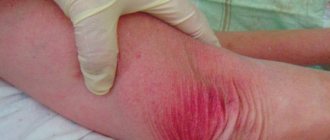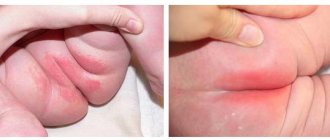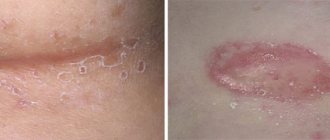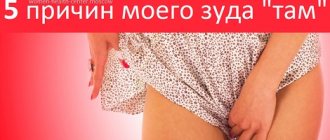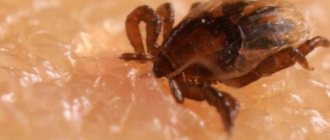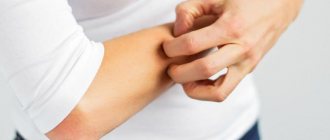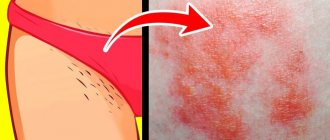Bedsores
Bedsores are formed as a result of constant compression of soft tissues. Simply put, when a person lies in one position for a long time, some parts of the body are constantly compressed. Blood circulation and nutrition are disrupted, soft tissues begin to slowly die. This is called soft tissue necrosis.
Important The process of bedsore formation “starts” after just two hours of body immobility!
Bedsores are characterized by a change in skin color with clear boundaries, swelling, and weeping wounds. If they are not treated promptly, the volume and depth of the lesions rapidly increase. Most often, bedsores occur on the heels, knees, elbows, tailbone, and buttocks. It depends on what position the person predominantly lies in.
There are 4 stages of development of bedsores .
Stage 1. Fading redness
What does it look like:
A pale area of skin or, conversely, persistent redness. The skin is not damaged. If you press your finger into the center of the redness area, the skin will turn pale. This suggests that microcirculation is not impaired.
Stage 1 bedsore on the back. Photo: CPP
Stage 1 bedsore. Photo: ECDO Center
To be sick, but to smile is the norm. Alexey Vasikov, director of the Blacksmith Lobov House of Mercy, about what “norm” means for a seriously ill person and why it sometimes surprises us
Alexey Vasikov
About palliative care
How to treat
It is important to prevent the process of bedsore formation from developing further. Make sure that the person does not lie on the injured area, use protective film breathable bandages (like a “second skin”).
By the way, in this article we describe in detail what types of dressings there are and in what cases what to use.
You can lightly massage healthy skin around the redness area - stroke it clockwise. It is permissible to use activating agents for massage. They improve blood microcirculation in tissues, which leads to improved metabolic processes in tissues, and therefore to an improvement in their condition and increased resistance to negative factors.
These products include special creams and gels with camphor or guarana. But remember, under no circumstances should you use camphor alcohol.
and similar means.
This article will help you understand the variety of foams, dry shampoos, creams and lotions for hygiene, including in special cases - bedsores, stoma, urinary and fecal incontinence.
Stage 2. Non-fading redness
What it looks like: Skin color - bluish-red, spots with clear edges; skin with superficial damage - abrasions, blisters. Usually already accompanied by pain.
Stage 1 bedsore. Photo: Palliative Care Center, Moscow
Stage 2 bedsore. Photo: Palliative Care Center, Moscow
How to deal with unpleasant odors in the home of a seriously ill person Why do unpleasant odors form, is there a specific “smell of old age” and how to deal with this problem
Kristina Osotova
Care
How to treat
It is necessary to prevent the wound from becoming infected. It should be rinsed with sterile saline at room temperature, and then a transparent semi-permeable film, hydrocolloid or foam dressing should be applied. To prevent the formation of bedsores from developing further, follow all anti-bedsore procedures.
Stage 3. Damage to the skin up to the muscle layer or with penetration into the muscles
What it looks like: The edges of the wound are well demarcated, surrounded by swelling and redness; the inside of the wound may be yellow or red. This is necrosis (tissue death) or granulation (tissue growth around). There may be liquid discharge. Hurts a lot.
Stage 2 bedsore. Photo: Palliative Care Center, Moscow
Stage 3 bedsore. Photo: Palliative Care Center, Moscow
Video: Treatment of deep bedsoresWhat to do and how to care if a person has deep bedsores and you do not have the opportunity to see a doctor
Irina ProkopenkoCaring workshop
Care
How to treat
Stage 3 bedsores should only be treated by a doctor. It will cleanse the wound of exudate (liquid that is released from small blood vessels during inflammation) and pus. He will remove necrotic (dead) tissue surgically or dissolve necrosis using special gel dressings, and wash the wounds with saline solution. For secondary infection and purulent discharge, he will prescribe antibacterial agents (for example, metronidazole).
It is important to ensure the absorption of discharge and protect the wound from drying out and infection. For this, atraumatic bactericidal and absorbent dressings are used: based on beeswax with bactericidal properties, hydrogel, based on calcium alginate. They may also have a hemostatic effect.
After cleansing the wound, you need to stimulate its healing process. And, of course, continue all necessary anti-bedsore procedures.
Stage 4. Damage to all soft tissues, tendons and bones visible
What it looks like : Many holes are formed that can connect. The bottom of the wound often fills with black or black-brown masses of decaying tissue. Very strong, unbearable pain.
Stage 4 bedsore. Photo: Palliative Care Center, Moscow
Last stage bedsore, tissue necrosis. Photo: ECDO Center
How to treat
Such bedsores can also only be treated by a doctor. It does the same thing as stage 3 pressure ulcers, plus adds prophylaxis and bleeding control if necessary. For this purpose, atraumatic dressings are used and locally - a solution of ethamsylate and aminocaproic acid, calcium alginate.
Important Sometimes bedsores form in very unexpected places - for example, on the head. Read about this in the article “Bedsores on the head: prevention and treatment.”
Bedsores. Test for those caring for seriously ill people Do you know enough about caring for a sedentary person? Test your knowledge. Caring workshop
Symptomatic treatment
Causes of rashes on the buttocks of a child
08.10.2021
An allergic reaction to your child's bottom, which includes rashes, redness and itchy blisters, may indicate that the child is having a severe allergic reaction . What type exactly?
Allergic contact dermatitis
Contact dermatitis (which is an inflammation of the skin) is caused by an allergic reaction to something that comes into contact with the skin. This often includes chemicals found in the soap you use to bathe your baby. Or in powder, with which you wash your child’s clothes. Butt and leg allergies may also develop when a child wears pants or underwear that have been washed using a certain detergent that contains allergenic chemicals. Cleaning chemicals used on toilets may be another cause of butt rash.
Food allergies
Food and drug allergies Peanuts, shellfish, strawberries, and avocados are just a few of the foods that can cause allergic reactions .
Allergic purpura
Allergic purpura is also a serious, often life-threatening allergic reaction that can cause a skin rash, most often on a child's bottom, arms, or legs . Purpura can affect joints , gastrointestinal tract and kidneys , so be vigilant.
Hives
Hives are an allergic reaction caused by an allergen to which the child is susceptible. Allergens in this case usually enter the body through food or inhaled air, as opposed to simple contact with the skin (as in allergic contact dermatitis ). Hives are always accompanied by an itchy rash.
Eczema
Eczema or atopic dermatitis is characterized by long-lasting, scaly and itchy rashes throughout the body. Exposure to certain substances may worsen eczema . Treatment for eczema includes the use of moisturizing baby hypoallergenic creams, steroid cream, avoiding substances that worsen symptoms and the effects of antihistamines.
Types of allergic rash on the butt
1) Acute: allergic reaction / urticaria - a reaction usually to food or insect bites. The rash tends to be pink and bumpy and itchy. The rash may come and go in 3-7 days, even after the initial trigger has gone away. treated with diphenhydramine. Cooling the skin with water or ice can be soothing and soothe itching. If your child has difficulty breathing or swelling of the face or lips, contact your doctor right away.
2) Chronic: atopic dermatitis and eczema . This is a very dry and irritated rash.
It can appear anywhere on the body, including the butt. When the spots are only dry and not red, use moisturizers to treat it. When the spots are bright red, doctors advise using 0.5 - 1% hydrocortisone about three times a day for 5 days.
Published in Pediatrics Premium Clinic
Diaper rash
Most often, diaper rash (inflammation) forms in places where the skin constantly rubs, is damp and there is no access to air - for example, on the neck, in the armpits, under the breasts (in women), in the folds of the abdomen, in the groin folds, between the fingers. The main cause of diaper rash is poor hygiene. Sometimes taking certain chemotherapy drugs also contributes to diaper rash.
Diaper rash is characterized by itchy irritation, burning, and pain. The skin changes color, the boundaries of redness are blurred. There is an unpleasant smell.
Diaper rash differs from bedsores in the main symptoms of manifestations, the mechanism of development and the predominant localization.
There are 3 degrees of development of diaper rash:
1st degree. Initial
What it looks like: redness and itching without visible damage to the skin.
How to treat
Cleanse your skin regularly, allowing it to “breathe.” Replace bedding and underwear with seamless ones made from soft and natural fabrics. To make a person sweat less, review his diet and food temperature (food should be warm, not hot).
Organization of therapeutic nutrition for a seriously ill person Why appetite worsens, how to check swallowing function and what to feed a seriously ill person Olga Kotelnikova
Care
Wash the affected areas of the skin with an infusion of oak bark, chamomile, sage or string. After the procedure, let the skin dry thoroughly and powder with baby powder or potato starch. Or you can apply products with zinc or arginine - a thin layer until completely absorbed.
2nd degree. Moderate lesions
What it looks like:
skin is damaged. There are ulcers on it, there is itching and burning.
How to treat
Use mild, non-traumatic antiseptic solutions (chlorhexidine, rivanol, etc.) and agents for restoring the epidermis (dexpanthenol, bepanthen). To relieve itching, reduce inflammation and dry the skin, use antihistamines, as well as ointments or pastes (Lassara, Teymurova, Desitin).
3rd degree. Severe defeats.
What it looks like:
deep non-healing cracks, unpleasant odor. The affected area increases. There is a burning sensation and pain.
How to treat
The treatment approach is the same as in the 3rd stage of bedsore treatment.
All actions should be aimed at preventing the development of infection, relieving pain and reducing inflammation.
